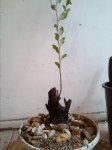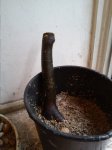Am in a similar situation as OP and hoping for advice on collecting an oak I just found this evening, need to double-check it to see if it's a Live or Laurel oak, but hoping someone (especially
@rockm!) could tell me if my approach is correct: found the tree (~2" thick trunk, first primary branch at maybe 6" from the ground, very healthy-looking / not dormant), cut it back to the first branch, trenched/cut roots, watered heavily and left it there.
If I'm remembering correctly, the best approach from here would be to wait until spring, when buds have formed but haven't broken (unsure how this truism applies to something that's
already growing, waiting for something to set buds in spring seems like it'd only apply to something that'd been dormant...), and collect then, ideally after a week of going and watering daily to encourage more feeder-roots beneath the trunk.
Would love to know what to alter in my approach (and why, of course

), I wanted to get it today when doing the prep work and thought "well, you're supposed to collect deciduous in winter" but am not thinking that applies here, not to a tree that's looking good / not dormant (if I'm wrong I'd happily go dig it up tomorrow, or maybe after a couple weeks of daily waterings to promote better rooting under the trunk (IME the problem w/ collecting oaks is their lack of feeder roots at their base and they just don't grow roots vigorously like some other specie))
Can get a pic if it'd help but it's now around 1' tall (I left it taller than needed for die-back and leverage when collection time comes), if it were ilex/bougie/crape I *know* I could collect today but I've only gotten 1 oak to survive so far (am at 2mo, I
think it's survived!) so want to be sure I'm doing everything exactly right! If I could go back to my interventions today I'd have gotten under it and checked its tap-root, I think it may actually be worth going back and opening-up my trench so I can get at the tap-root, just afraid it'd be such a drastic move that I'd kill the thing...
Thanks for any tips on this one, it's not just an oak for the sake of getting an oak (like my current one), it actually seems like solid stock, so really want to be sure to get this!! (Oh and if anyone knows whether Live / Laurel oaks are harder than the other to collect, it'd be very useful to know! Am trying to start collecting native trees that aren't bougies/crapes!)
? There are 3 Q. rubra in my collection also but only about 4 years old. Biggest is starting to take shape. Below link to most excellent huge leafed Oak Bonsai.



